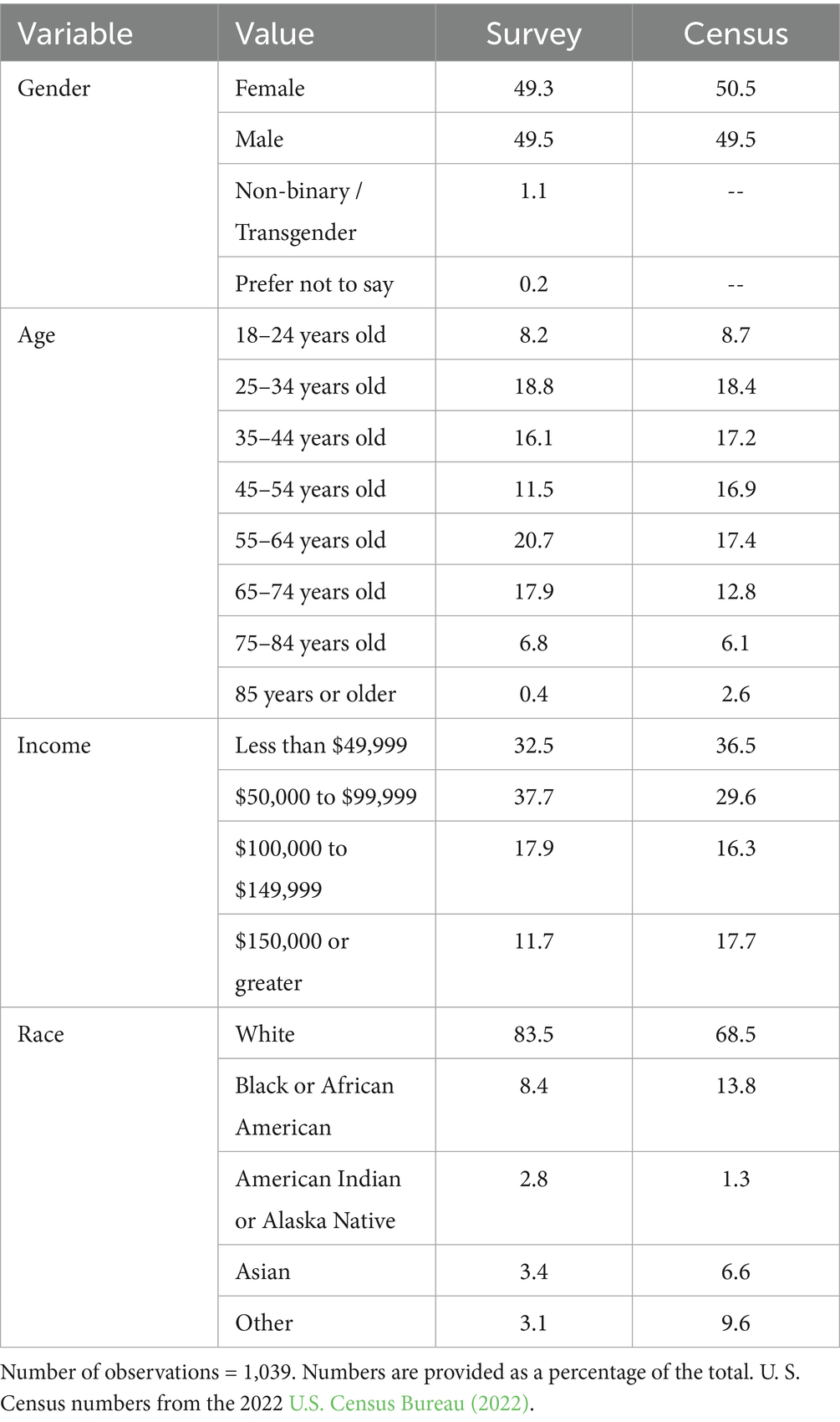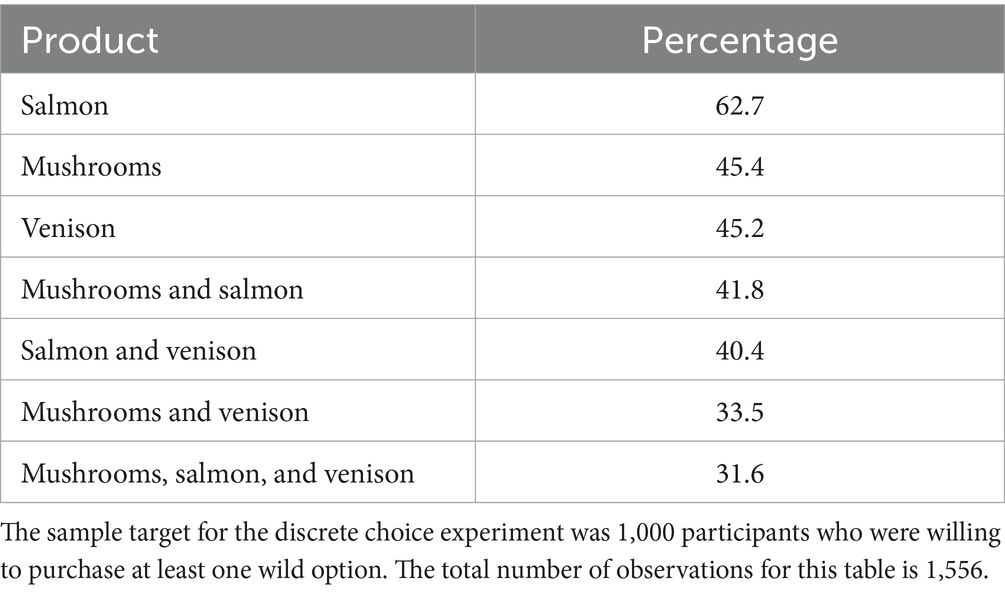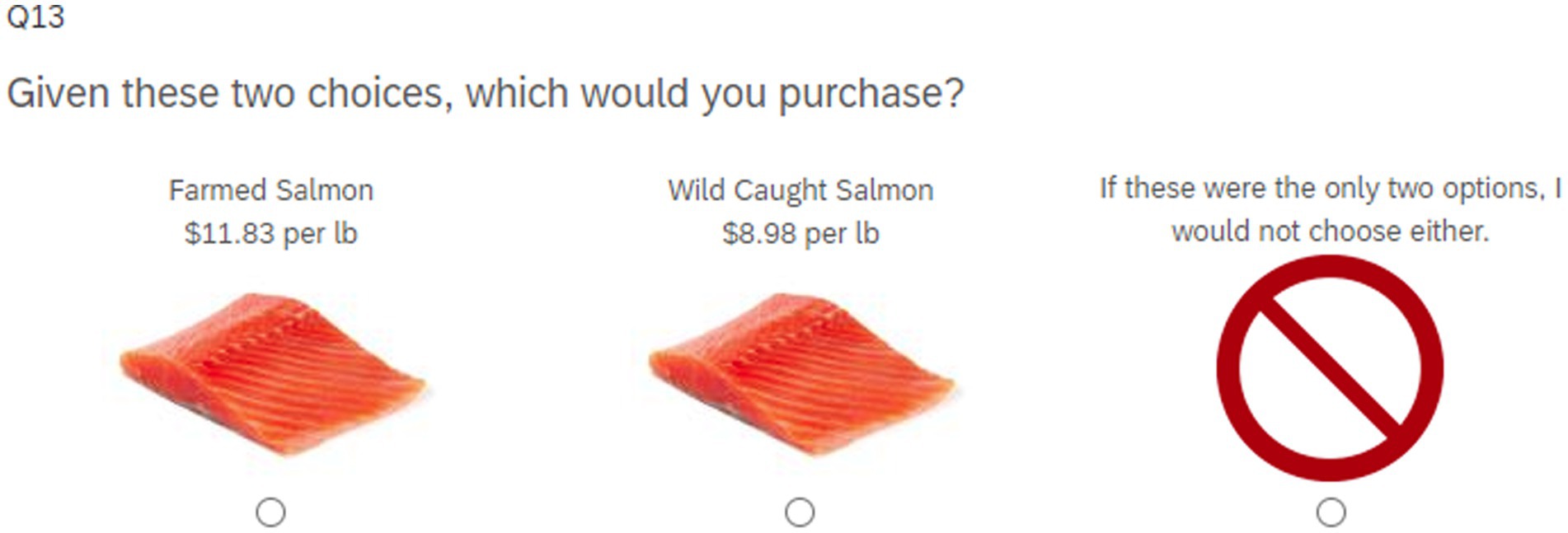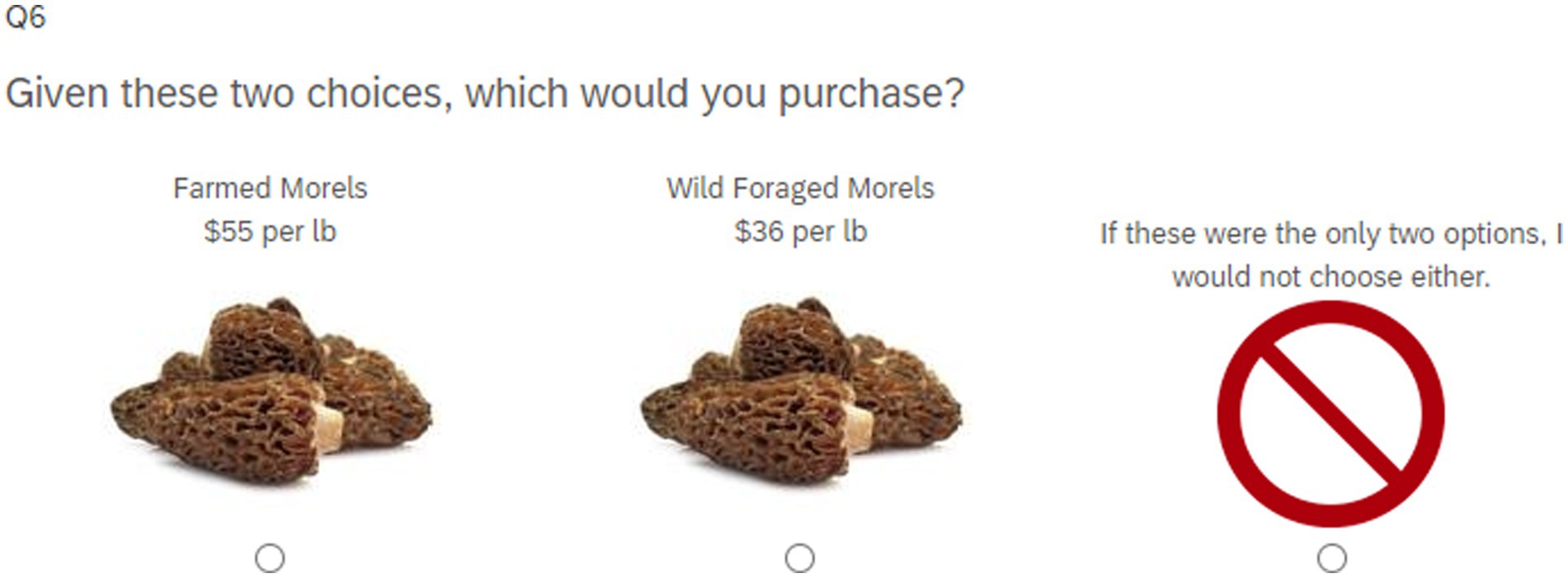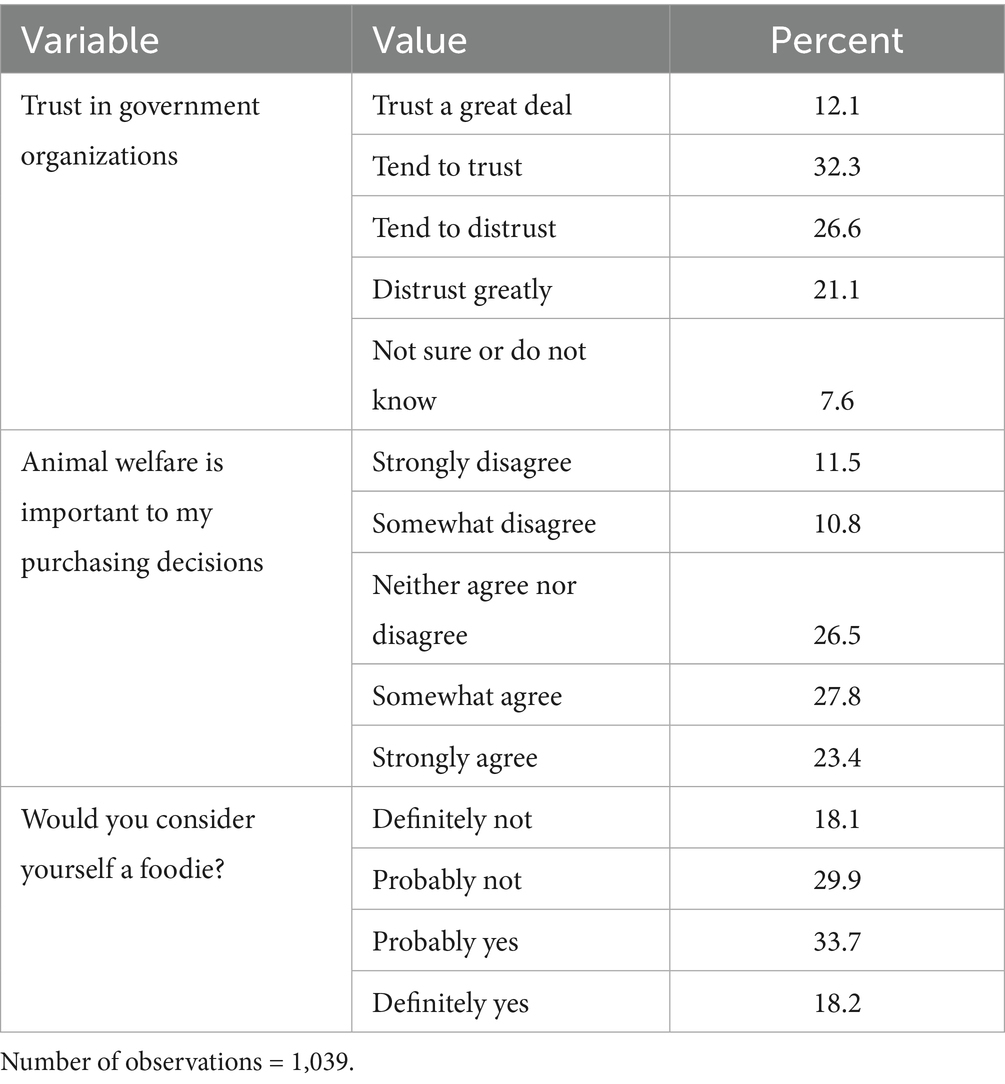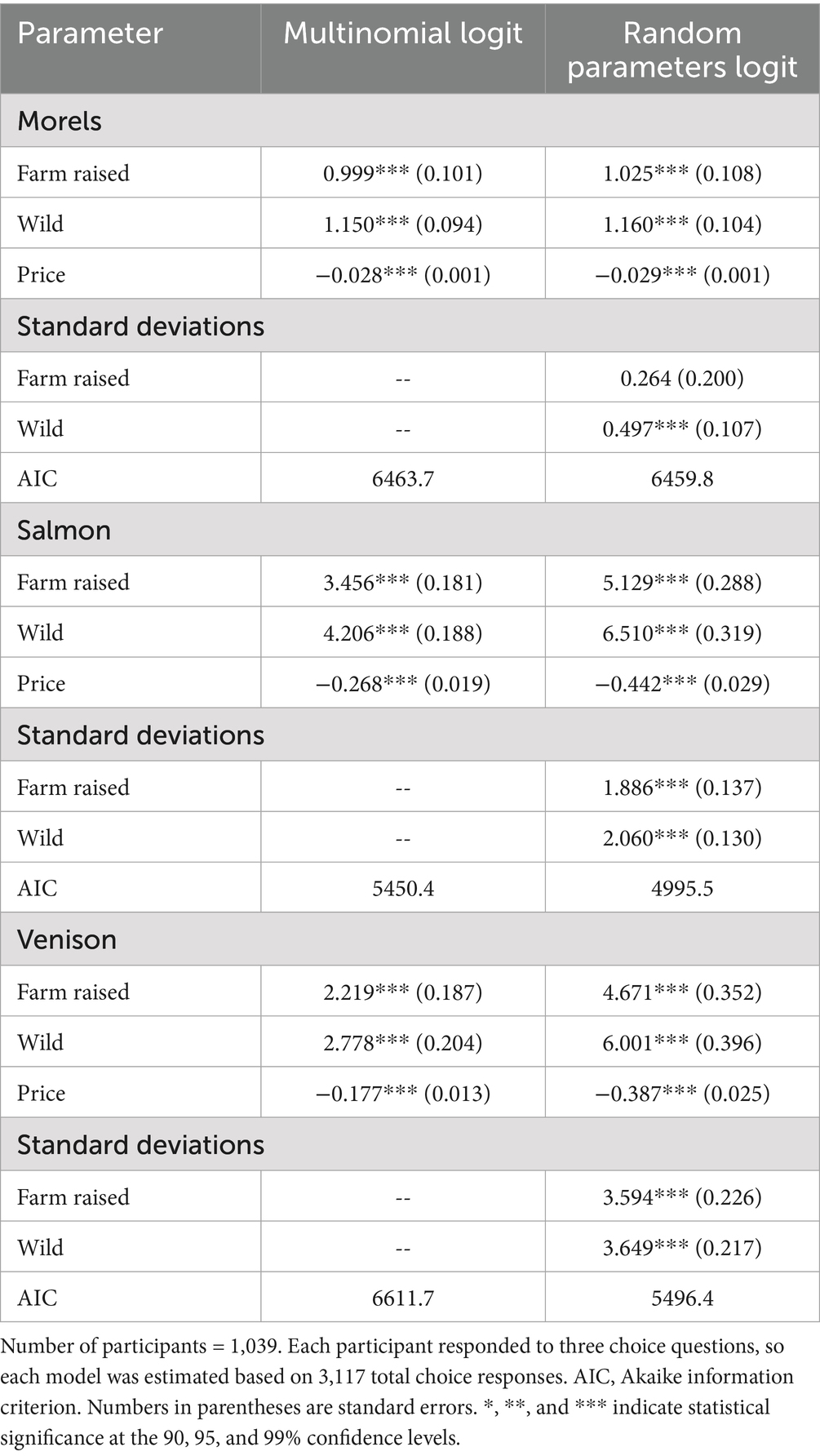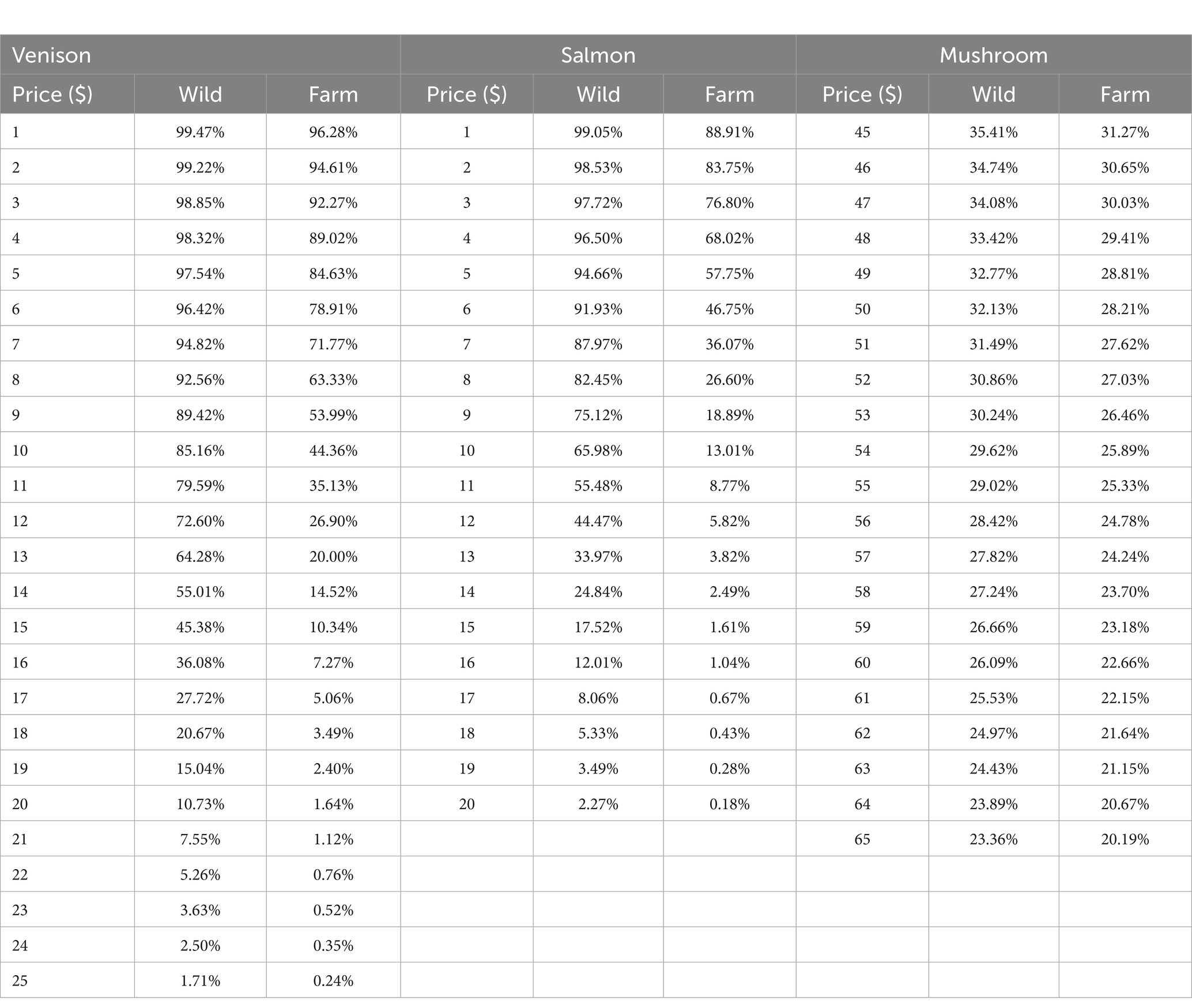- 1Department of Agricultural Economics, Purdue University, West Lafayette, IN, United States
- 2Department of Agricultural Economics and Agribusiness, University of Arkansas, Fayetteville, AR, United States
Introduction: Consumer demand for authenticity and sustainability in food systems is growing, creating both opportunities and challenges for entrepreneurs in niche and specialty markets. While wild-foraged and hunted foods are often perceived as more “natural” and sustainable, attempts to scale these products through farming may compromise their perceived authenticity.
Methods: To explore these dynamics, we conducted discrete choice experiments with a nationally representative sample of 1,039 U.S. consumers. Participants evaluated their willingness to pay (WTP) for salmon, venison, and morel mushrooms, presented in both wild-foraged/hunted and farm-raised forms.
Results: Consumers exhibited strong preferences for wild versions of all three products, with average premiums of $5.09 for salmon, $7.47 for venison, and $4.73 for morels. Perceptions of naturalness and minimal human intervention largely drove these premiums. Additional attitudinal predictors of WTP included concern for animal welfare, distrust in government regulation, and identification with foodie culture. However, these preferences reflected characteristics that consumers cannot verify, suggesting that scaling via farming may reduce market value by undermining product authenticity.
Discussion: Our findings highlight an “authenticity paradox”: while wildness drives consumer demand, efforts to commercialize and expand production may erode the very attributes that generate value. Entrepreneurs in niche food markets must carefully balance ecological sustainability, product scaling, and consumer trust. Strategic messaging and transparent sourcing practices may help preserve perceived authenticity while enabling market growth.
1 Introduction
Identifying sustainable niche market opportunities is a core challenge in entrepreneurship, particularly when aligned with environmental or social impact goals (Dean and McMullen, 2007; Evans et al., 2017; Schaltegger and Wagner, 2011; Schaltegger et al., 2016). Misinterpreting consumer demand can be exceptionally damaging for small and medium-sized agri-food enterprises, which are often considered pivotal contributors to sustainable economic development but are considered riskier to start and typically have higher burn rates (Bylund and Malone, 2024; Nooteboom, 1994; Klewitz and Hansen, 2014; Lynde, 2020; Rossi et al., 2023).
While the prior literature addresses how entrepreneurs explore market opportunities, this study emphasizes the importance of accurately assessing the total addressable market for agri-food businesses. This gap is particularly important as modern consumers continue their shift toward “authentic” and “sustainable” food products (Khessina et al., 2023; Malone et al., 2025; Pozner et al., 2022; Schifeling and Demetry, 2021; Verhaal et al., 2022). Specifically, we use a series of discrete choice experiments to demonstrate that misinterpreting consumer demand characteristics can lead to overestimating the market size and risking business viability.
The burgeoning wild food market presents a unique arena for academic exploration for several reasons (Anand et al., 2021; Ploum et al., 2018; Sarma et al., 2022). At its core is the “authenticity paradox,” which refers to the complex dynamic in niche markets where, when a firm gains market success, it affects its ability to maintain an authentic identity (Verhaal and Dobrev, 2022). The paradox lies in the fact that as a firm’s popularity grows, the appeal of its authenticity declines because the increased market success, which is often associated with scalability and high growth, is less aligned with the intrinsic motivations and social values that were initially associated with the firm’s authenticity. In the case of wild foods extracted from the natural environment, a firm’s success in the market can also lead to negative environmental outcomes such as overfishing or forest degradation (Coll et al., 2008; Jackson et al., 2001). For example, some states have implemented rigorous training requirements to restrict excessive foraging of products such as wild mushrooms (Malone et al., 2022).
Entrepreneurs must understand the consumer psychology associated with their market segmentation strategy (Woolley et al., 2022). We focus on how consumer preferences shape entrepreneurial opportunities in agri-food markets where environmental degradation is a concern (Jolink and Niesten, 2015; York and Venkataraman, 2010). Specifically, we investigate how misinterpreting consumer associations with perceived authenticity, sustainability, and animal welfare concerns influences an agri-food entrepreneur’s opportunity evaluation for farm-raised products initially produced via foraging, fishing, and hunting.
The remainder of this article is organized as follows. Section 2 provides a background on how growth in demand for wild food can lead to entrepreneurial opportunities for U. S. farms. In Section 3, we develop a conceptual framework describing the market dynamics associated growing farm-raised food as a substitute in response to increased demand for their wild-caught products. Section 4 describes our experimental design, which involves a discrete choice experiment involving 1,039 U. S. consumers. We outline our results in Section 5, which indicate that the consumer demand for farm-raised products is generally lower than that of their wild-foraged counterparts. However, in some market niches, consumers might be willing to substitute the less environmentally damaging alternative. Our article concludes in Section 6 with a discussion of the current study’s limitations, recommendations for future research, and recommendations for sustainable food systems.
2 Wild food in the United States
U. S. consumers increasingly embrace niche agri-food products via novel marketing channels, leading to a heightened interest in native, “wild,” and indigenous options. Compounding interest is the recent push for diets such as the Paleolithic diet, which directs followers to eat only the foods that humans during the Paleolithic era ate. Similarly, the modern “wild food movement” extends advocacy for alternative food systems, rooted in post-modern views that reject traditional, industrialized food systems reminiscent of the “back-to-the-land” movement of the 20th-century (Malone and Norwood 2020; Phillips, 2019). Consider The Omnivore’s Dilemma, which describes multiple food systems as alternatives for omnivore (human) consumption (Pollan, 2006). Specifically, Pollan addresses industrialized agriculture, organic food, local food, and wild food (food hunted or foraged in some way), arguing that industrialized agriculture harms human and ecosystem health while showing potential alternatives. Similarly, Kimmerer (2013) emphasizes the disconnect that industrialized and technology-focused agriculture creates between people and their food and people and the land. These authors support the increasingly-popular notion that wild food systems might promote a more holistic approach to sustainable food systems.
Market opportunities for wild food entrepreneurs are not new or limited to fad diets; some consumers believe that wild food solves perceived environmental, nutritional, and moral problems in traditional food systems (Popkin, 2002). During the COVID-19 pandemic and resulting stay-at-home orders of early 2020, interest in foraging as a safe hobby and a way to reconnect with food increased. Several influencers on social media sharing foraging tips and tricks saw a huge increase in views and followers, including Alexis Nikole Nelson, also known as the “Black Forager,” who has over 4.3 million followers on new media platforms such as Instagram and TikTok (Mohtasham and Zomorodi, 2021). Nelson describes her connection to foraging as a way to access cheaper food and connect with her ecosystem and with “African American and Indigenous food traditions that many people were discouraged—or actively prevented—from accessing” (Mohtasham and Zomorodi, 2021). These vibrant online and social communities have been particularly effective at increasing the popularity of niche wild food products (Hoskins et al., 2021; Sachdeva et al., 2018).
In addition to inducing food policy change, social movements can create room for niche market opportunities (Malone and Norwood 2020; Biedny et al., 2020). However, research on these kinds of opportunities has been particularly limited in the United States due to the complex history of foraging, specifically through trespassing laws and often confusing policies around the legality of harvesting and hunting certain species (Weber et al., 2008; Sawers, 2015, 2022). Hunting many wild products requires a permit; some foods can be harvested only during certain seasons. However, hunting and foraging remain culturally popular, and that positive view of the activities themselves could translate to the value of wild products, even if the consumer did not forage it themselves (Demartini et al., 2018, 2021).
Additionally, the sales step in the vertical marketing chain can change consumer valuation of the local product, as local inputs are perceived as less worthy of a premium than local outputs (Staples et al., 2021a). Niche marketers might also popularize changes in product flavor profiles via “terroir” effects to increase willingness to pay (Staples et al., 2021b). Even within the same product, consumer willingness to pay for a niche product might differ based on the marketing channel. For example, though consumers are typically willing to pay a premium for local foods, they are not willing to pay premiums for local food sold at farmers’ markets, and discount it when purchased directly from an urban farm (Printezis and Grebitus, 2018).
The notion of “wildness” in food preferences is especially unique because it is a credence attribute that insists on omitting agricultural productivity. For our purposes we define wild food as edible plants, fungi, and animals that are harvested or collected from their natural, unmanaged habitats, rather than being cultivated or farmed. These foods grow spontaneously in forests, meadows, mountains, and bodies of water and are typically gathered rather than grown through agricultural practices. Wild foods include a variety of species such as wild fruits, nuts, mushrooms, herbs, greens, and game. They are often prized for their natural flavors, nutritional value, and the connection they provide to the local ecosystem and traditional culinary practices. The concept of wild food also often encompasses a broader ethos of sustainability, traditional knowledge, and a minimal ecological footprint, distinguishing these foods from those produced in conventional agricultural systems. As wild food has been brought into popular culture in cycles, many Indigenous people, rural Black and white Americans, and immigrants have been carrying on these traditions. In much of the rural Southern United States, including Appalachia and the Ozarks, foraging has been embedded in the food culture, coinciding with subsistence farming as a way for poor, rural communities to remain economically viable during seasons of inclement weather or bad economic times (Campbell, 2014).
At the same time, increased demand for foraged foods can significantly damage native ecosystems. Overfishing is the most drastic example, as demand for wild-caught fish has created the collapse of some coastal ecosystems (Coll et al., 2008; Jackson et al., 2001). Increased foraging has also increased environmental degradation concerns, leading urban planners to call for added policy considerations for the practice (Shackleton et al., 2017; Synk et al., 2017). Thanks to these concerns, researchers and entrepreneurs alike have sought to establish practices that might increase the supply of traditionally wild-foraged food products (e.g., Malone et al., 2022).
3 Conceptual framework
Figure 1 presents a conceptual framework for the dynamic development of farm-raised food markets as entrepreneurs expand their production away from wild-forage production systems. The quantity of wild foods supplied in a market is limited by what can be harvested from a naturally occurring quantity (Figure 1A). Natural growth rates, harvest regulations, seasonality, and ecological considerations can all influence the supply curve for wild food products (Malone et al., 2022). Additionally, harvesting wild foods can be more labor-intensive, risky, and unpredictable than farm-raising, often leading to higher prices from a restricted supply curve. In that market scenario, we can define Equation 1 as the total addressable market (TAM) for the all-wild market as the product of the equilibrium price and quantity:

Figure 1. Conceptual framework. (A) Only wild. (B) Expanded supply due to cultivation. (C) Unique farm-raised demand.
Given the substantial limitations on wild-forage products, the relatively high equilibrium price will likely attract agri-food entrepreneurs interested in cultivating wild products. Indeed, wild foods are also limited in a way that farmed foods are not; if agricultural producers project increased demand for a farm-raised product, they can plant more during the proceeding growing season. Producers may even invest in technology and practices to increase their yield with increasing consumer demand. Developing a commercialized production process relaxes constraints on the supply curve, connecting supply to traditional supply variables such as production cost, technology, and the price of inputs.
Figure 1B introduces this farm-raised cultivation ( , shifting the supply curve to the right. The added supply expands the equilibrium quantity demanded from QWild to QˈWild while the equilibrium market price will likely decline from PWild to PˈWild. Thus, the first practical inference from our simple conceptual framework is that standardized production of wild products expands product supply, reducing the expected equilibrium price an entrepreneur might expect. This reduction in price can often be disastrous for an upstart niche agricultural market, though the extent of the change in the size of the TAM is a function of the slope of the demand curve. The extent to which this increase in supply changes an entrepreneur’s total addressable market can be stated in Equation 2 as:
Figure 1B assumes that consumers consider wild and farm-raised foods the same product, where the added production shifted the pre-existing supply curve. That said, the prior literature indicates that consumers often consider production decisions as a “credence attribute,” which is a quality or characteristic of a product that cannot be verified by the consumer even after purchase and consumption (Lusk, 2018). Credence attributes contrast with “search attributes” like color, price, or size, which consumers can determine before purchase, and “experience attributes” like taste or texture, which can be assessed after purchase but before consumption. Examples of credence attributes can include a food’s organic status, carbon footprint, fair trade certification, animal welfare standards, or, in this case, whether a product is wild-foraged or farm-raised. Figure 1C demonstrates the updated TAM for an agri-food entrepreneur who begins cultivating a product that was previously available only via wild foraging after we adjust the extent of the market to a decline in demand due to “wildness” as a credence attribute in Equation 3:
4 Methods
Our empirical findings come from discrete choice experiments for three unique wild products (venison, salmon, and morel mushrooms) embedded within a survey of 1,039 U. S. adults who had purchased at least one of these wild foods in the previous 6 months. The study was approved by the relevant University Institutional Review Board.
4.1 Experimental design and sampling strategy
After indicating their informed consent to participate, each participant answered three questions about each product, which were randomly selected from a fractional factorial design. We used this approach for three reasons. First, this approach allows us to collect data from a more representative sample than in-person surveys, which is particularly valuable for the entrepreneurship literature (Bylund and Malone, 2024; Malone et al., 2019; Williams et al., 2019). Second, a hypothetical experiment is required because farm-raised products for two study items (morels and venison) are limited. Finally, while there are concerns about hypothetical bias in stated preference DCEs, we are interested in the marginal differences between wild and farm-raised. Prior studies have indicated that marginal value estimates between stated and revealed preference studies is consistent (Lusk and Schroeder, 2004; Johnston et al., 2017).
Data were collected via the professional sampling company SSI-Dynata in March 2023. On average, participants completed the survey in 8.12 min. Table 1 presents our consumer sample in comparison to the U.S. census. Note that our sample skews slightly older, with higher percentages in the 55–64 and 65–74 groups, and less racial diversity than the census. Most of the sample was white, 83.5%, while only 68.5% of the U.S. population is white, which is unsurprising given our focus on likely consumers of wild foods.
To be admitted as a survey participant, respondents had to be willing to purchase a wild product. Table 2 presents the percentage of the sample who selected one or more of the three options when asked about their willingness to purchase a wild version of each option. Salmon was the most popular, with 62.8% of respondents indicating they would be willing to purchase wild salmon, with about 45% each for mushrooms and venison. About one-third of the sample indicated they would be willing to purchase a wild version of all three.
4.2 Survey structure and key variables
We focus on several relevant variables to understand consumer behavior dynamics for wild foods. Among these, “Animal Welfare Concerns” reflects the degree to which consumers are concerned about animal welfare and ethical treatment in food production. This variable is particularly relevant in choosing wild and farm-raised proteins, as consumers with high animal welfare concerns might prefer wild proteins, perceiving them as more ethical or natural than their farm-raised counterparts. Similarly, we explore the level of trust consumers have in government regulations and standards related to food safety and production. Higher trust might lead to greater confidence in the safety and quality of farm-raised foods. In contrast, lower trust may incline consumers towards wild foods, which are perceived as less affected by government-regulated farming practices. Finally, we consider “foodies,” which refers to consumers who spend a larger share of their income on food at home and away from home (Malone et al., 2025). We anticipate that this consumer segment may be more open to exploring and valuing the unique attributes of wild foods, driven by their pursuit of culinary diversity.
To calculate our TAM, we simulate demand curves for three unique wild-forage products: salmon, venison, and morel mushrooms. Figure 2 presents a sample choice question for wild versus farm-raised salmon. U.S. consumers ate an estimated 19 pounds of fish and shellfish per capita in 2020 (National Oceanic and Atmospheric Administration, 2022). Approximately 79% of that consumption is imported rather than U.S. wild-caught or from U.S. aquaculture producers (Abaidoo et al., 2021). A robust literature has explored differences in willingness-to-pay between farm-cultivated and wild-caught seafood, generally indicating that wild-caught fish typically receive higher premiums due to perceptions of quality, freshness, and safety (Claret et al., 2014; Verbeke et al., 2007; Menozzi et al., 2023; Wongprawmas et al., 2022). However, some literature has shown that consumers can have negative perceptions of wild-caught fish due to concerns about overfishing or exposure to mercury (Hall and Amberg, 2013).
Figure 3 presents a sample choice question for wild versus farm-raised venison. Wild game is one of the most widely discussed wild food products, second to seafood. This category includes wild boar, and venison, of which the legality of hunting and selling varies by region and country. The literature around the value of wild game is based primarily in Europe because of the large market and its long history, as well as the high cultural demand by consumers (Marescotti et al., 2019). The United States also has a strong hunting culture. However, little is known about the potential market for hunted animals because legislation on selling hunted products is at the state level.
Figure 4 presents a sample choice question for wild versus farm-raised morel mushrooms. While many people forage as a hobby or passion, the high prices of specific mushroom types, especially morel mushrooms, lead some to sell their harvest. However, over 70% of morels were supplied at costs below $30/lb (Malone et al., 2022). That said, the extent of the morel market remains unclear. Understanding consumer premiums for this market allows us to contrast the salmon and venison premiums with a plant-based product, allowing us to more easily isolate the potential impact of animal welfare assumptions on the value of wildness.
4.3 Empirical estimation
To explore the differences in TAM for these products, we estimated discrete choice models via a random parameter logit (RPL) model to calculate the wild and farm-raised price premiums individually. These models allow each participant to have their own utility function within the empirical estimation, which is assumed to follow a normal distribution, which was accomplished with a simulated maximum likelihood estimation with 1,000 Halton draws. From the demand system created by our RPL estimations, we first simulate a series of implied demand schedules that link price to the quantity demanded for each farm-raised and wild product. In other words, we estimate the probability that the average participant chooses a product at a range of prices. We hold the base prices for the complementary product constant for each implied demand curve at the median price presented in the DCE. To test items that might explain those differences, we use the individual-specific parameter estimates generated by the RPL to regress individual differences in willingness to pay between WTP for wild-foraged and for farm-raised against the variables collected (Animal Welfare Concerns, Government Trust, Foodie). We also include an interaction effect for animal welfare and the specific product, as we anticipate that animal welfare is likely to explain gaps between salmon and venison WTP but not for morels.
5 Results
We asked three questions to understand the key factors that might predict why a consumer might be willing to pay less for farm-raised food (Table 3). Overall, respondents were evenly split between trust or distrust in government organizations, with roughly 48% answering either “tend to distrust” or “distrust greatly” versus 44% stating they “tend to trust” or “trust a great deal.” However, those in the trust category skewed more to weaker trust, with only 12% saying they trusted greatly. Respondents answered that animal welfare was either “somewhat” or “strongly” important to their purchasing decisions, with a combined 54%. Only 22% answered that they “somewhat” or “strongly” disagreed that animal welfare was important, and the remaining 27% marked “neither disagree or agree.” Our final key factor was the perceived quality of food, and we asked respondents if they considered themselves “foodies.” Over half, 52%, said either “probably” or “definitely” yes, while 48% said “probably” or “definitely” not. The largest group was those saying, “probably yes,” with 33.7%.
Table 4 presents the empirical results derived from the three discrete choice experiments. The RPL model fits the data better, based on the Akaike information criterion (AIC) for each model, so we focus the remainder of our discussion of the results on these parameter estimates. Consumer utility for all three wild products was higher than for the farm-raised products, with salmon having the largest difference, followed by venison and morels. This finding is consistent with the size of the WTP estimates, which are derived by dividing the mean parameter estimate by the non-random price parameter and multiplying by −1. The difference in mean WTP was highest for venison at $7.47, followed by salmon at $5.09 and morels at $4.73.
Figures 5A–C display the implied demand curves for each food product. Corresponding demand schedules can be found in Appendix A1. As expected, all three products show a higher demand for wild products over farm-raised products, with salmon having the largest premium, venison in the middle, and morels having the smallest premium. While the literature overall is somewhat mixed about premiums for salmon, the results support that consumers are willing to pay a premium for wild-caught salmon. The demand curve for wild-caught salmon is significant, with an average willingness to pay of $5.09 across all consumers surveyed. The implied demand curve for venison is similar to that of salmon, with an average willingness to pay of $7.47. While the previous literature on the premiums for wild game is limited, this finding supports the conclusion that products labeled “wild” instead of “farm-raised” are perceived as more valuable to consumers. The implied morel demand curve stands out from the other two as being steeper and farther to the left. The overall average premium for all consumers was $4.73. Though the overall demand is lower, the curve’s steepness shows that the consumers who prefer wild, prefer morels and are less concerned about price changes. The mean willingness to pay for all products and all consumers was $5.76.

Figure 5. Implied demand curves for wild and farm-raised products. (A) Venison. (B) Salmon. (C) Morels.
Table 5 represents three regressions that explore the impact of the three key beliefs related to willingness to pay. The first examines the hypothesis variables exclusively and finds they are all significant, with increasing government trust correlating with decreasing willingness to pay, and an increase in identifying as a “foodie” correlating with decreasing willingness to pay. The second regression includes both hypothesis variables and product distinctions and indicates that venison and morel mushrooms (captured in the intercept) are significant, while salmon is not. The final regression includes all the previous variables, along with controls for the interaction between animal welfare preferences for wild salmon and venison, which shows a slight increase in WTP, but which is not significant for either product.
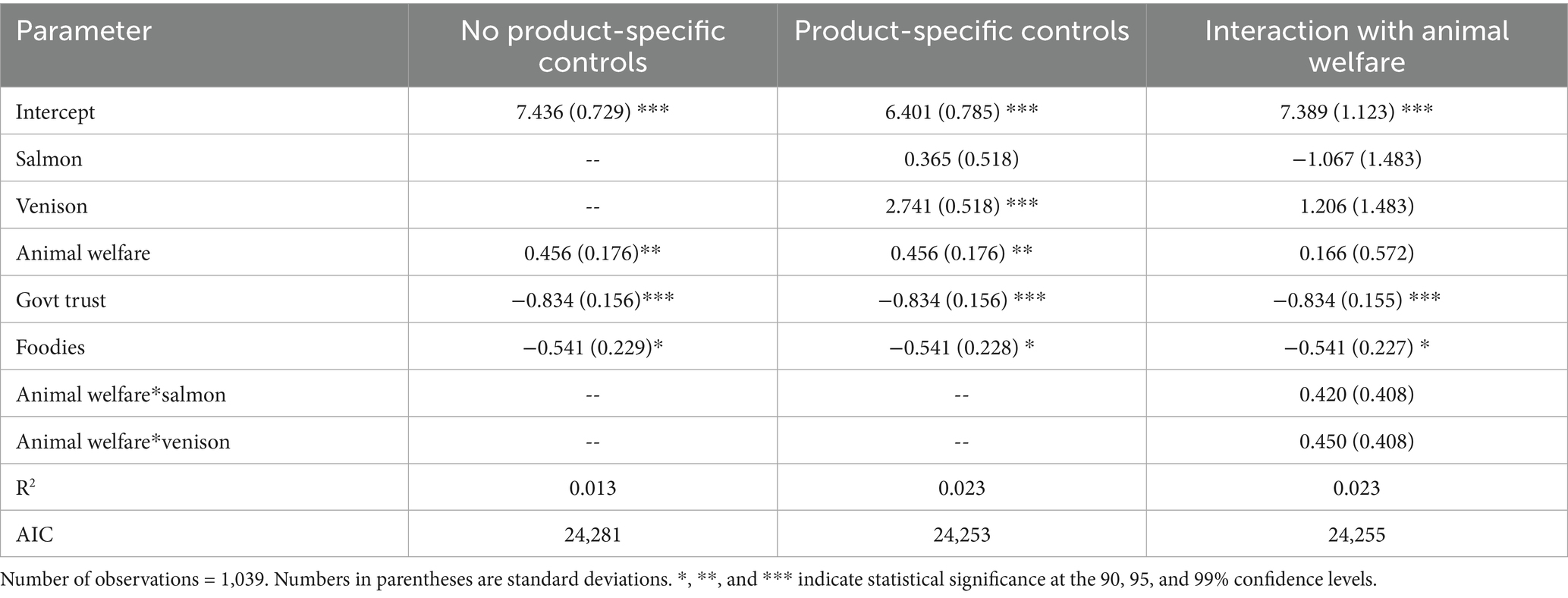
Table 5. Regression results predicting individual-specific differences in willingness-to-pay for wild and farm-raised foods.
We anticipated that premiums for wild foods are likely a function of views on traditional versus alternative food systems, political views, and animal welfare views. In addition to the questions looking to quantify consumer WTP for wild products, we also asked the follow-up question, “When you hear the word ‘wild,’ what two words come to mind?” Figure 6 presents those findings. In addition to the counterpart, “unfarmed,” Many of the most popular words associated with wildness were words emphasizing the connection to the natural environment, such as “nature,” “raw,” “unprocessed,” and “chemical-free.” While not all the words had a positive connotation (“feral” and “dangerous” were also commonly listed), the strong emphasis on factors related to quality, taste, and safety supports our argument that the demand curves for wild products and farm-raised products occupy unique places in a consumer’s utility function.
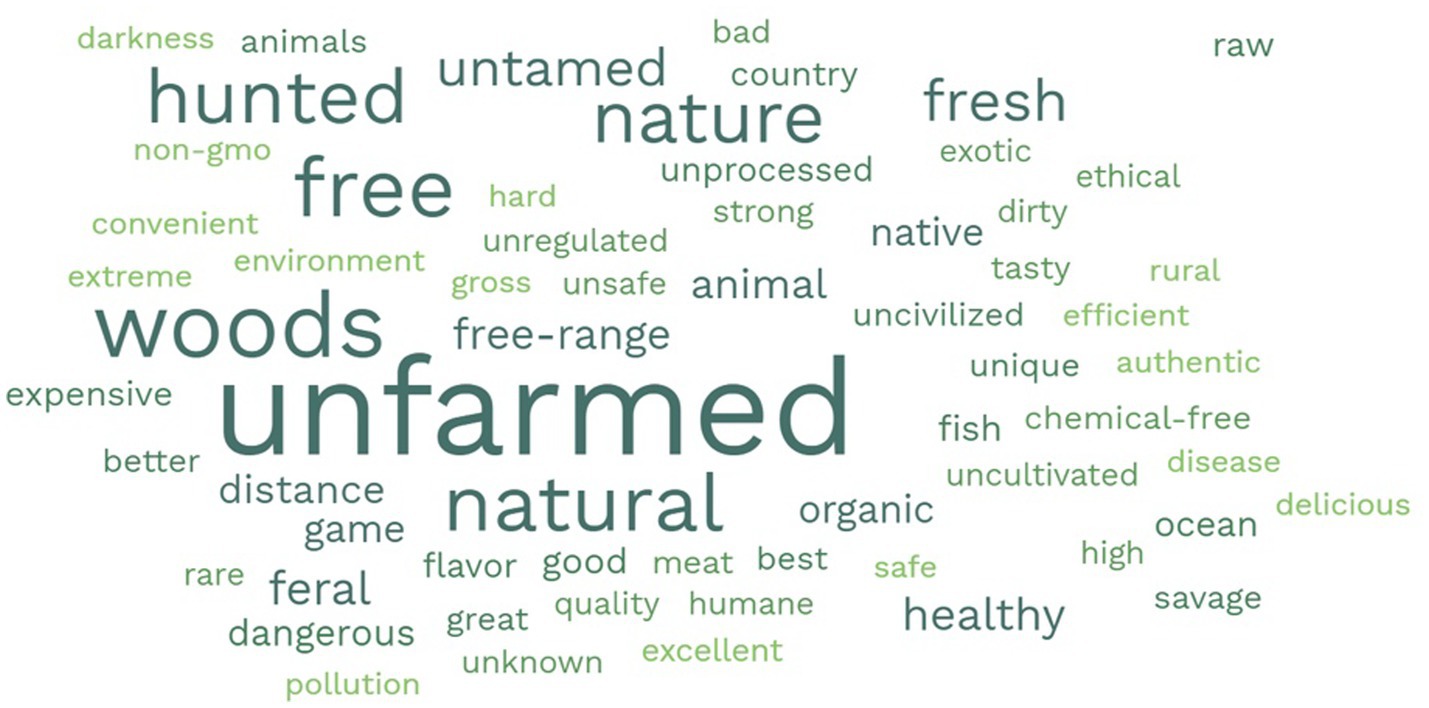
Figure 6. Qualitative responses to the question, “When you hear the world “wild,” what two words come to mind?”
It is also worth noting that our sample consisted of people willing to purchase wild foods, as participants had to indicate a willingness to purchase at least one of the wild food options. In a follow-up question, we asked, “If prices were the same, how much more likely are you to choose a wild option over a farm raised option?” Among the participants who indicated a willingness to purchase wild foods but an unwillingness to purchase specific wild foods, we found a limited interest if prices were the same. Only 25% of those unwilling to purchase wild mushrooms were open to purchasing them if the prices were the same. Similarly, 21% of the venison holdouts were interested in wild venison if the prices were the same, and 45% of the fish holdouts were open to wild salmon if the prices were the same. This limited interest indicates that price is not the determining factor in many potential consumers’ choice not to purchase wild food options.
6 Conclusion
While beneficial regarding consistency and quality, advancements in agricultural technology can push some nostalgia-driven consumers towards alternative food systems. This article encourages a deeper exploration of the market dynamics for wild versus farm-raised food products as the agri-food system addresses heightened sustainability concerns. Consumers see “wildness” as an important differentiator, and the uniqueness of a lack of agricultural cultivation intrinsically limits the supply of products in these markets. Thus, agri-food entrepreneurs interested in historically “wild” products must be especially aware of their market demand, as any oversight could lead to overestimating the total addressable market.
Our comparison of farm-raised and wild-foraged demand curves highlights the inherent tension producers face. While shifting to farmed production may address environmental constraints, it can also lead to a potential loss in consumer demand, restricting the entrepreneur’s market opportunity. Our empirical analysis encourages producers to more effectively gauge the market size for foraged products, as the size and scope of each market vary considerably. The supply of wild products is typically steeper than farm-raised products, as their labor is more labor-intensive and reaches a natural maximum capacity dictated by environmental constraints.
This study emphasizes the importance of assessing consumer preferences and demand dynamics in identifying economic feasibility in entrepreneurial decision-making. Our results imply that effective demand assessment must be integrated into business plans in addition to production cost data, capital requirements, and revenue projections. Understanding how changes in demand are tied to economic tradeoffs would help entrepreneurs better evaluate whether scaling strategies can succeed without compromising authenticity or sustainability.
Our analysis provides a few other key implications for future research. A vital area of exploration is estimating supply curves to ascertain whether wild and farm-raised products differ in this regard. Additionally, regional variations in entrepreneurial opportunities for wild and farm-raised foods warrant further investigation, as the historical connection to regional wild-harvested products (Moreno and Malone, 2021). By extension, future research might consider the regional variation in entrepreneurial opportunity for wild and farm-raised foods. Furthermore, our DCE did not include all the production attributes of the farm-raised products, potentially including organic versus conventional and greenhouse-grown versus field-grown. Further research might unpack the relationship between these credence attributes and overall views on agriculture to expand market opportunities for agri-food entrepreneurs.
This article also highlights the important role that food hubs and university innovation centers can play in helping agri-food entrepreneurs more accurately assess market demand. As entrepreneurial assistance programs have proliferated in recent decades (Batterink et al., 2010; Berti and Mulligan, 2016; Lovgren et al., 2019), so too has the risk of fueling speculative bubbles - a recurring challenge in the agri-food sector (Saitone and Sexton, 2007). These support systems can help mitigate overinvestment in market fads by equipping entrepreneurs with better tools for understanding demand. Our findings further highlight the need to integrate demand assessment training into agri-food education programs, which have expanded in reach and relevance (Oliveira and Cardoso, 2021).
6.1 Implications for entrepreneurs
For entrepreneurs and the organizations that support them, the challenge is to grow sustainable food ventures without erasing the intangible attributes that give them value. Food hubs and university innovation centers can play a critical role in helping entrepreneurs conduct demand assessments and refine their go-to-market strategy. Our findings highlight the importance of demand assessment, but they also point to a broader need for strategic communication, transparent production practices, and thoughtful innovation that preserves consumer trust. Wild food markets might offer entrepreneurial opportunities only if their distinctiveness is carefully stewarded. Our findings suggest several actionable strategies for entrepreneurs navigating niche and specialty food markets:
1. Test before you scale: Given the steep drop-off in demand for farm-raised substitutes, entrepreneurs should use pilot markets or direct-to-consumer trials to validate demand before investing in scaled production.
2. Reinforce credence attributes through branding: Since consumers associate “wildness” with values like naturalness and ethical treatment, marketing efforts should clearly communicate how farm-raised alternatives preserve these values (e.g., “wild-inspired,” “low-intervention,” or “heritage-grown”).
3. Segment based on consumer values: Targeting consumers with strong animal welfare concerns or low trust in government regulation may improve adoption of farm-raised substitutes, as these groups appear to drive demand differentials.
4. Guard against dilution of authenticity: Entrepreneurs should be mindful that over-commercialization or inconsistent messaging can erode the premium associated with “wild” products. Maintaining authenticity—even symbolically—can preserve value.
Data availability statement
The data that support the findings of this study are available from the corresponding author upon reasonable request. Due to restrictions related to participant confidentiality and survey licensing agreements, the full dataset is not publicly shared. Summary statistics and code used for analysis are available upon request.
Ethics statement
The studies involving humans were approved by University of Arkansas Institutional Review Board. The studies were conducted in accordance with the local legislation and institutional requirements. The participants provided their written informed consent to participate in this study.
Author contributions
TM: Conceptualization, Funding acquisition, Methodology, Investigation, Project administration, Resources, Supervision, Writing – original draft, Writing – review & editing. CC: Data Curation, Formal analysis, Resources, Software, Validation, Visualization, Writing – review & editing.
Funding
The author(s) declare that financial support was received for the research and/or publication of this article. This research was supported by the Great Lakes Aquaculture Collaborative, NOAA grant #NA19OAR4170388.
Conflict of interest
The authors declare that the research was conducted in the absence of any commercial or financial relationships that could be construed as a potential conflict of interest.
Generative AI statement
The authors declare that Gen AI was used in the creation of this manuscript. Generative AI was used to improve the readability of the manuscript.
Publisher’s note
All claims expressed in this article are solely those of the authors and do not necessarily represent those of their affiliated organizations, or those of the publisher, the editors and the reviewers. Any product that may be evaluated in this article, or claim that may be made by its manufacturer, is not guaranteed or endorsed by the publisher.
References
Abaidoo, E., Melstrom, M., and Malone, T. (2021). The growth of imports in U.S. seafood markets. Choices 36, 1–10. Available at: https://www.jstor.org/stable/27187708
Anand, A., Argade, P., Barkemeyer, R., and Salignac, F. (2021). Trends and patterns in sustainable entrepreneurship research: a bibliometric review and research agenda. J. Bus. Ventur. 36, 106092–106024. doi: 10.1016/j.jbusvent.2021.106092
Batterink, M. H., Wubben, E. F., Klerkx, L., and Omta, S. W. F. (2010). Orchestrating innovation networks: the case of innovation brokers in the Agri-food sector. Entrep. Reg. Dev. 22, 47–76. doi: 10.1080/08985620903220512
Berti, G., and Mulligan, C. (2016). Competitiveness of small farms and innovative food supply chains: the role of food hubs in creating sustainable regional and local food systems. Sustain. For. 8, 616–647. doi: 10.3390/su8070616
Biedny, C., Malone, T., and Lusk, J. L. (2020). Exploring polarization in U.S. food policy opinions. Appl. Econ. Perspect. Policy 42, 434–454. doi: 10.1002/aepp.13053
Bylund, P. L., and Malone, T. (2024). Understanding the role of perceptions in opportunity evaluation: a discrete choice experiment. Entrep. Res. J. 14, 759–796. doi: 10.1515/erj-2021-0232
Campbell, B. C. (2014). Just eat peas and dance: field peas (Vigna unguiculata) and food security in the Ozark highlands, U.S. J. Ethnobiol. 34, 104–122. doi: 10.2993/0278-0771-34.1.104
Claret, A., Guerrero, L., Ginés, R., Grau, A., Hernández, M. D., Aguirre, E., et al. (2014). Consumer beliefs regarding farmed versus wild fish. Appetite 79, 25–31. doi: 10.1016/j.appet.2014.03.031
Coll, M., Libralato, S., Tudela, S., Palomera, I., and Pranovi, F. (2008). Ecosystem overfishing in the ocean. PLoS One 3:E3881. doi: 10.1371/journal.pone.0003881
Dean, T. J., and McMullen, J. S. (2007). Toward a theory of sustainable entrepreneurship: reducing environmental degradation through entrepreneurial action. J. Bus. Venturing 22, 50–76. doi: 10.1016/j.jbusvent.2005.09.003
Demartini, E., Vecchiato, D., Marescotti, M. E., Gibbert, M., Viganò, R., Giacomelli, S., et al. (2021). The more you know: the equivocal effects of prior knowledge on preferences for hunted vs. farmed wild boar meat. Int. J. Gastron. Food Sci. 24:100325. doi: 10.1016/j.ijgfs.2021.100325
Demartini, E., Vecchiato, D., Tempesta, T., Gaviglio, A., and Viganò, R. (2018). Consumer preferences for red deer meat: a discrete choice analysis considering attitudes towards wild game meat and hunting. Meat Sci. 146, 168–179. doi: 10.1016/j.meatsci.2018.07.031
Evans, S., Vladimirova, D., Holgado, M., Van Fossen, K., Yang, M., Silva, E. A., et al. (2017). Business model innovation for sustainability: towards a unified perspective for creation of sustainable business models. Bus. Strateg. Environ. 26, 597–608. doi: 10.1002/bse.1939
Hall, T. E., and Amberg, S. M. (2013). Factors influencing consumption of farmed seafood products in the Pacific northwest. Appetite 66, 1–9. doi: 10.1016/j.appet.2013.02.012
Hoskins, J., Gopinath, S., Verhaal, J. C., and Yazdani, E. (2021). The influence of the online community, professional critics, and location similarity on review ratings for niche and mainstream brands. J. Acad. Mark. Sci. 49, 1065–1087. doi: 10.1007/s11747-021-00780-4
Jackson, J. B., Kirby, M. X., Berger, W. H., Bjorndal, K. A., Botsford, L. W., Bourque, B. J., et al. (2001). Historical overfishing and the recent collapse of coastal ecosystems. Science 293, 629–637. doi: 10.1126/science.1059199
Johnston, R. J., Boyle, K. J., Adamowicz, W., Bennett, J., Brouwer, R., Cameron, T. A., et al. (2017). Contemporary guidance for stated preference studies. J. Assoc. Environ. Resour. Econ. 4, 319–405. doi: 10.1086/691697
Jolink, A., and Niesten, E. (2015). Sustainable development and business models of entrepreneurs in the organic food industry. Bus. Strat. Environ. 24, 386–401. doi: 10.1002/bse.1826
Khessina, O. M., Verhaal, J. C., and Dobrev, S. D. (2023). Bottled up or poured out: how product name emotions affect appeal and authenticity in the market for craft beer. Strategy Science 8, 464–483. doi: 10.1287/stsc.2022.0178
Kimmerer, R. W. (2013). Braiding sweetgrass: Indigenous wisdom, scientific knowledge and the teachings of plants (First paperback edition. Minneapolis, MN: Milkweed Editions.
Klewitz, J., and Hansen, E. G. (2014). Sustainability-oriented innovation of SMEs: a systematic review. J. Clean. Prod. 65, 57–75. doi: 10.1016/j.jclepro.2013.07.017
Lovgren, A., Ross, R. B., Leschewski, A., and Peterson, H. C. (2019). Do entrepreneurial assistance programs create value for Agri-food entrepreneurs? Entrep. Res. J. 10, 1–14. doi: 10.1515/erj-2018-0016
Lusk, J. L. (2018). Separating myth from reality: an analysis of socially acceptable credence attributes. Annu. Rev. Resour. Econ. 10, 65–82. doi: 10.1146/annurev-resource-100517-023153
Lusk, J. L., and Schroeder, T. C. (2004). Are choice experiments incentive compatible? A test with quality differentiated beef steaks. Am. J. Agric. Econ. 86, 467–482. doi: 10.1111/j.0092-5853.2004.00592.x
Lynde, R. (2020). Innovation & entrepreneurship driving food system transformation. Physiol. Behav. 220, 112866–112864. doi: 10.1016/j.physbeh.2020.112866
Malone, T., Koumpias, A. M., and Bylund, P. L. (2019). Entrepreneurial response to interstate regulatory competition: evidence from a behavioral discrete choice experiment. J. Regul. Econ. 55, 172–192. doi: 10.1007/s11149-019-09375-y
Malone, T., Lusk, J., and Lusk, H. (2025). Demographic insights and perspectives of American foodies. Br. Food J. 127, 2253–2267. doi: 10.1108/BFJ-10-2024-1075
Malone, T., and Norwood, F. B. (2020). Gluten aversion is not limited to the political left. Agric. Hum. Values 37, 1–15. doi: 10.1007/s10460-019-09958-7
Malone, T., Swinton, S. M., Pudasainee, A., and Bonito, G. (2022). Economic assessment of morel (Morchella spp.) foraging in Michigan, USA. Econ. Bot. 76, 1–15. doi: 10.1007/s12231-022-09548-5
Marescotti, M. E., Caputo, V., Demartini, E., and Gaviglio, A. (2019). Discovering market segments for hunted wild game meat. Meat Sci. 149, 163–176. doi: 10.1016/j.meatsci.2018.11.019
Menozzi, D., Wongprawmas, R., Sogari, G., Gai, F., Parisi, G., and Mora, C. (2023). The role of objective and subjective knowledge on the attitude and intention of Italian consumers to purchase farmed and wild fish. Agric. Food Econ. 11, 47–72. doi: 10.1186/s40100-023-00288-1
Mohtasham, D., and Zomorodi, M.. (2021). Meet Alexis Nikole Nelson, The Wildly Popular “Black Forager.” National Public Radio. Accessed online at: https://www.npr.org/sections/codeswitch/2021/09/09/173838801/meet-alexis-nikole-nelson-the-wildly-popular-black-forager (Accessed June 30, 2025).
Moreno, F. F., and Malone, T. (2021). The role of collective food identity in local food demand. J. Agric. Resour. Econ. 50, 22–42. doi: 10.1017/age.2020.9
National Oceanic and Atmospheric Administration . (2022). Fisheries of the United States-NOAA fisheries. Accessed online at: https://www.fisheries.noaa.gov/national/sustainable-fisheries/fisheries-united-states (Accessed June 30, 2025).
Nooteboom, B. (1994). Innovation and diffusion in small firms: theory and evidence. Small Bus. Econ. 6, 327–347. doi: 10.1007/BF01065137
Oliveira, L., and Cardoso, E. L. (2021). A project-based learning approach to promote innovation and academic entrepreneurship in a master's degree in food engineering. J. Food Sci. Educ. 20, 120–129. doi: 10.1111/1541-4329.12230
Phillips, J. M. (2019). Hipbillies: Deep revolution in the Arkansas Ozarks. Fayetteville, AR: University of Arkansas Press.
Ploum, L., Blok, V., Lans, T., and Omta, O. (2018). Exploring the relation between individual moral antecedents and entrepreneurial opportunity recognition for sustainable development. J. Clean. Prod. 172, 1582–1591. doi: 10.1016/j.jclepro.2017.10.296
Pollan, M. (2006). The omnivore’s dilemma: A natural history of four meals. New York, NY: Penguin Press.
Popkin, G. (2002). Ditch your grocery store. Go foraging instead. Washington Post. Accessed online at: https://www.washingtonpost.com/magazine/2022/08/15/wild-foods-foraging-eating-healthy/ (Accessed June 30, 2025).
Pozner, J. E., DeSoucey, M., Verhaal, J. C., and Sikavica, K. (2022). Watered down: market growth, authenticity, and evaluation in craft beer. Organ. Stud. 43, 321–345. doi: 10.1177/0170840621993236
Printezis, I., and Grebitus, C. (2018). Marketing channels for local food. Ecol. Econ. 152, 161–171. doi: 10.1016/j.ecolecon.2018.05.021
Rossi, E. S., Materia, V. C., Caracciolo, F., Blasi, E., and Pascucci, S. (2023). Farmers in the transition towards sustainability: what is the role of their entrepreneurial identity? Front. Sustain. Food Syst. 7, 1–14. doi: 10.3389/fsufs.2023.1196824
Sachdeva, S., Emery, M. R., and Hurley, P. T. (2018). Depiction of wild food foraging practices in the media: impact of the great recession. Soc. Nat. Resour. 31, 977–993. doi: 10.1080/08941920.2018.1450914
Saitone, T. L., and Sexton, R. J. (2007). Alpaca lies? Speculative bubbles in agriculture: why they happen and how to recognize them. Applied Economic Perspectives & Policy 29, 286–305. doi: 10.1111/j.1467-9353.2007.00343.x
Sarma, S., Attaran, S., and Attaran, M. (2022). Sustainable entrepreneurship: factors influencing opportunity recognition and exploitation. Int. J. Entrep. Innov. 25, 1–14. doi: 10.1177/14657503221093007
Sawers, B. (2015). Property law as labor control in the postbellum south. Law Hist. Rev. 33, 351–376. doi: 10.1017/S0738248015000012
Sawers, B. (2022). What lies behind that ‘no trespass’ sign. The Atlantic. Accessed online at: https://www.theatlantic.com/ideas/archive/2022/07/the-true-meaning-of-no-trespass/661471/ (Accessed June 30, 2025).
Schaltegger, S., Lüdeke-Freund, F., and Hansen, E. G. (2016). Business models for sustainability: a co-evolutionary analysis of sustainable entrepreneurship, innovation, and transformation. Organ. Environ. 29, 264–289. doi: 10.1177/1086026616633272
Schaltegger, S., and Wagner, M. (2011). Sustainable entrepreneurship and sustainability innovation: categories and interactions. Bus. Strateg. Environ. 20, 222–237. doi: 10.1002/bse.682
Schifeling, T., and Demetry, D. (2021). The new food truck in town: geographic communities and authenticity-based entrepreneurship. Organ. Sci. 32, 133–155. doi: 10.1287/orsc.2020.1369
Shackleton, C. M., Hurley, P. T., Dahlberg, A. C., Emery, M. R., and Nagendra, H. (2017). Urban foraging: a ubiquitous human practice overlooked by urban planners, policy, and research. Sustain. For. 9:1884. doi: 10.3390/su9101884
Staples, A. J., Malone, T., and Sirrine, J. R. (2021a). Hopping on the localness craze: what brewers want from state-grown hops. Manag. Decis. Econ. 42, 463–473. doi: 10.1002/mde.3246
Staples, A., Sirrine, J. R., Mull, A., Stuhr, S., Adams, A., and Malone, T. (2021b). Untapping beer terroir: experimental evidence of regional variation in hop flavor profiles. Tech. Q. 59, 7–16. doi: 10.22004/ag.econ.321849
Synk, C. M., Kim, B. F., Davis, C. A., Harding, J., Rogers, V., Hurley, P. T., et al. (2017). Gathering Baltimore’s bounty: characterizing behaviors, motivations, and barriers of foragers in an urban ecosystem. Urban For. Urban Green. 28, 97–102. doi: 10.1016/j.ufug.2017.10.007
U.S. Census Bureau . (2022). American Community Survey 1-year estimates. Available at: https://www.census.gov/programs-surveys/acs
Verbeke, W., Sioen, I., Brunsø, K., De Henauw, S., and Van Camp, J. (2007). Consumer perception versus scientific evidence of farmed and wild fish: exploratory insights from Belgium. Aquac. Int. 15, 121–136. doi: 10.1007/s10499-007-9072-7
Verhaal, J. C., and Dobrev, S. D. (2022). The authenticity paradox: why the returns to authenticity on audience appeal decrease in popularity and iconicity. J. Manage. 48, 251–280. doi: 10.1177/0149206320950414
Verhaal, J. C., Hahl, O., and Fandl, K. J. (2022). Authenticity-based connections as organizational constraints and the paradox of authenticity in the market for Cuban cigars. Organ. Sci. 34, 1–22.
Weber, K., Heinze, K. L., and DeSoucey, M. (2008). Forage for thought: mobilizing codes in the movement for grass-fed meat and dairy products. Admin. Sci. Q. 53, 529–567. doi: 10.2189/asqu.53.3.529
Williams, D. W., Wood, M. S., Mitchell, J. R., and Urbig, D. (2019). Applying experimental methods to advance entrepreneurship research: on the need for and publication of experiments. J. Bus. Venturing 34, 215–223. doi: 10.1016/j.jbusvent.2018.12.003
Wongprawmas, R., Sogari, G., Gai, F., Parisi, G., Menozzi, D., and Mora, C. (2022). How information influences consumers’ perception and purchasing intention for farmed and wild fish. Aquaculture 547:737504. doi: 10.1016/j.aquaculture.2021.737504
Woolley, J. L., Pozner, J. E., and DeSoucey, M. (2022). Raising the bar: values-driven niche creation in U.S. bean-to-bar chocolate. Strategy Science 7, 27–55. doi: 10.1287/stsc.2021.0147
York, J. G., and Venkataraman, S. (2010). The entrepreneur–environment nexus: uncertainty, innovation, and allocation. J. Bus. Venturing 25, 449–463. doi: 10.1016/j.jbusvent.2009.07.007
Appendix
Keywords: agri-food entrepreneurship, niche marketing, wild foods, market dynamics, sustainable food systems
Citation: Malone T and Cooper CF (2025) Cultivating the wild: strategies for entrepreneurs navigating niche and specialty food markets. Front. Sustain. Food Syst. 9:1571055. doi: 10.3389/fsufs.2025.1571055
Edited by:
Amar Razzaq, Huanggang Normal University, ChinaReviewed by:
Muhammad Majeed, University of Gujrat, PakistanHafiz Ullah, University of Chitral, Pakistan
Copyright © 2025 Malone and Cooper. This is an open-access article distributed under the terms of the Creative Commons Attribution License (CC BY). The use, distribution or reproduction in other forums is permitted, provided the original author(s) and the copyright owner(s) are credited and that the original publication in this journal is cited, in accordance with accepted academic practice. No use, distribution or reproduction is permitted which does not comply with these terms.
*Correspondence: Trey Malone, dGptYWxvbmVAcHVyZHVlLmVkdQ==
 Trey Malone
Trey Malone Courtney F. Cooper
Courtney F. Cooper